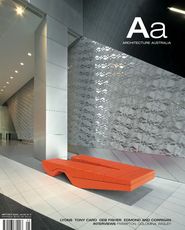ASPECT’S MEMORIAL TO EMERGENCY SERVICE WORKERS CONFRONTS THE COMPLEXITY OF CONTEMPORARY MEMORIALS, WHILE ALSO SEEKING TO DRAW VIEWERS IN WITH A SENSE OF SHARED EXPERIENCE. REVIEW BY SANDRA KAJI-O’GRADY.
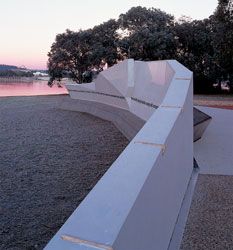
Looking along the east face of Aspect’s National Emergency Service Memorial, a thick, long concrete wall above Lake Burley Griffin.
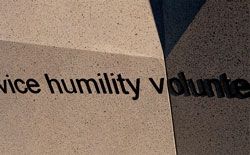
Detail of the text inscribed on the outer face.
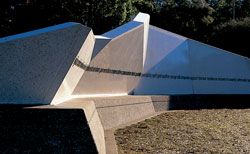
The folded forms create an intimate sheltered space.
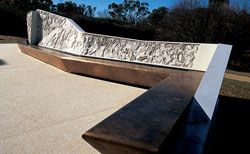
Relief sculpture covers the west face, showing the emergency services in action.
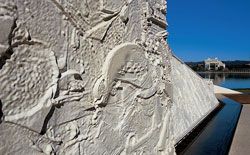
Detail.

Overview of the west face with Lake Burley Griffin beyond.
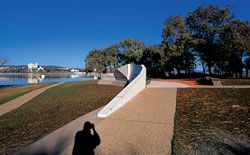
View from the access road. The wall’s tapered ends almost merge with the ground.
IN THE CENTRE of Palermo, Sicily, is an immodestly scaled complex of municipal buildings from the time of Mussolini’s reign in various styles of the period: stark Rationalism, the more decorative Novocento and an austere Art Deco. Each incorporates stone reliefs depicting acts of military and civilian heroism. The fire station sports a dramatic scene of three muscular firefighters. One carries a naked woman in his arms without any sign of strain. Her recumbent body could be the result of smoke inhalation, but might just as reasonably be explained as a swoon in the face of chivalry. Her long hair and right arm fall in stylized waves, compositionally balancing the flames that lick from an open window in the upper corner. The cult of Ancient Rome had been revived during the Fascist regime in Italy and is a clear source for the classical, wide-legged poses and noble profiles of the larger-than-life figures.
To risk one’s life to save others from the destruction of fire or other calamities is no less heroic an act in contemporary Australia, yet the unambiguous imagery of the Palermo monument is no longer available to us except as ironic kitsch. Contemporary monuments, such as the newly completed National Emergency Service Memorial in Canberra by Aspect Landscape Architects and Urban Designers, must therefore confront the absence of a shared and unambiguous monumental iconography.
Our cultural narratives are too complex and contradictory for a singular representation.
This is apparent in the exhibits about fire at the National Museum of Australia, across the lake from the memorial. There, the human capacity for courage and service to others is acknowledged, but so too is our complicity in disaster. The emergency services include police, fire and ambulance services, search and rescue agencies, as well as volunteer groups. In all the events for which these services are called out – fire, earthquake, flood, storm and also accidents and criminal acts – planning decisions, lack of forethought and the behaviour of those to be rescued frequently exacerbates vulnerability. It follows that the values upheld by the emergency services and the emotions experienced around and after an emergency are too complex and contradictory to be captured in a single image, form, gesture or word. Accordingly, Aspect’s monument comprises a thick, 23-metre-long concrete wall that zigzags across the slope of the Rond Terraces above Lake Burley Griffin, with the two sides treated differently.
As you approach the monument from the path that winds up from the lake and access road, the face of the wall is inscribed with a line of words – vigilance readiness coordination service humility volunteerism prevention cooperation camaraderie trust capability awe vulnerability spirit grief sacrifice courage skill compassion support honour resilience recovery humanity community hope. The inclusion of this text both alleviates and reinforces the difficulty of capturing this range of concerns in memorial form.
The wall circumscribes a sheltered space, intimate for one but large enough for groups and ceremonies and bordered on its open side by an existing stand of small trees and scrub.
The designers suggest the enclosing effect is akin to a blanket. By tapering the wall’s ends, achieving an overall horizontality, and complementing the site’s contours, a close relationship is formed with the landscape. The wall is sufficiently dramatic and hard-edged, though, to mark out a presence for itself in its immediate surroundings.
Like the Palermo monument, relief sculpture depicting the activities of the emergency services has been employed and here it takes up the full length of the inner face of the wall.
Developed in collaboration with artist Charles Anderson and sculptor/designer Darryl Cowie, it was produced using an innovative technique for transferring images to the concrete surface.
Its success relies substantially on the production of shadows within the relief and their interaction with the shadow cast by the viewer. Unfortunately, I visited the memorial on an overcast and dull Canberra day and, in the absence of sun and shadow, the imagery was elusive. Faces and figures dissolved one into another across the six panels without formal hierarchy, background and foreground, or pictorial focus. In the competition drawings, scenes of specific events with details of helicopters and rescue techniques are evident, but these were imperceptible through the blur of rain. The roles of rescuer and rescued, so blatantly obvious at Palermo, were not apparent. In place of narrative clarity, however, an emotive energy and brutality has been achieved which the static composition of the Italian scene lacks.
The National Emergency Service Memorial is the first on ground above Lake Burley Griffin designated for civilian memorials. Within walking distance of Anzac Parade and its memorials, it is separated and hidden from these by a busy road and a treed ridge, limiting its exposure to passing lakeside joggers and the most determined visitors. With the bronze ledge that runs the length of the frieze too wet and cold for sitting down, conditions did not favour prolonged reflection, yet traffic noise would make contemplation difficult at most times. While the design works with the open site, as a place for remembering our vulnerability to natural and human-caused disaster, and our debt to the volunteers and professionals in the emergency services, the memorial’s success is mitigated by a location somewhat hidden from broader public view.
DR SANDRA KAJI-O’GRADY IS A SENIOR LECTURER IN ARCHITECTURE AT THE UNIVERSITY OF MELBOURNE.
Project Credits
NATIONAL EMERGENCY SERVICE MEMORIAL, CANBERRA
National design competition winners Aspect Melbourne. Client National Capital Authority. Design team Aspect Melbourne in association with Charles Anderson, DCG Design, Martin Butcher Lighting Design. Landscape architect Aspect Melbourne— project team Kirsten Bauer, Tim Conybeare, Venta Slizys, Chris Razzell,Warwick Savvas, Cath Stutterheim. Frieze artist Charles Anderson.
Sculptor Darryl Cowie. Project managers National Capital Authority. Design and construct contractors DCG Design. Main contractors Urban contractors.
Superintendent SMEC Australia.

